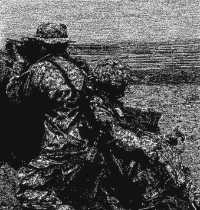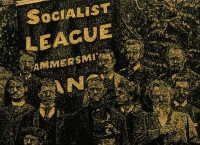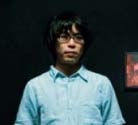Stitches in time
Text: Uchida Shinichi
Portrait: Nagare Satoshi
Aoyama Satoru’s astonishing embroideries made using an old sewing machine are frequently described as indistinguishable from paintings. In the intricate detail of his works, invariably one glimpses a more conceptual side – say a comment on the history of painting via a different medium – but with this artist, it all comes down to that first fateful encounter with a sewing machine, in this case while studying textiles at Goldsmiths College.
“I chose the course partly out of interest in becoming a designer, and the idea of working on a sewing machine seems to have been prompted by an early compulsion. What I didn’t expect was to find women constituting 90 percent of the students, and thus a heightened awareness not only of the relationship between industrial craft and fine art, but of issues such as gender and feminism. Inevitably I was compelled to consider what I as a male could do there, and what it might mean. Historically the sewing machine has been seen as a symbol of women’s labor, but on the other hand I have a very male obsession with the romance of old machinery. After wrestling with different ideas, I hit upon the approach of using this machine, one of the earliest examples of modern technology, to create works that redefine the contemporary environment.”

Glitter Pieces #2 2008
21.7x21cm
Photo Miyajima Kei
Courtesy the artist and Mizuma Art Gallery
For the solo exhibition Glitter Pieces #1-22, in a departure from his previous motifs – everyday scenes and objects – Aoyama embroidered photographic images plucked from print media, including frenzied fans at a music festival, George Bush’s final press conference as president, and what on initial inspection appear to be ordinary group photos. For the series he employed only black and two shades of metallic thread, and the resulting works project an aura found in neither paintings nor photographs. Or perhaps the sensation arises from a vague uneasiness at the way images consumed at a particular moment in time then no longer of interest are offered up again so vividly from a new departure point, that of embroidery.
In several of the works, images printed on the back of the chosen photographs have also been embroidered to form pairs. When these coincidental combinations include a news photo symbolizing the US economic crisis teamed with an advertisement urging people to purchase luxury apartments regardless, what are we supposed to think?
“It was a steep learning curve for me too, differing as it does from my usual approach, which is to aim for a painting-like quality. The shiny thread is also evocative of computer monitors, TV screens and the like, and I suspect my sense that embroidery is, when you come down to it, almost a pixellated form of expression, comes into it as well.”
When asked if he had any fears about running out of ideas, having elected to pursue such a singular path, Aoyama replies with a grin, “I was asked the same thing at my first solo show, and ten years on I still have plenty of things left to try, so I can’t say I’m too concerned.”

Glitter Pieces #1, 2008
17.4×23.2cm
Photo Miyajima Kei
Courtesy the artist and Mizuma Art Gallery

Aoyama Satoru
Born 1973 in Tokyo. BA in textiles from Goldsmiths College, University of London in 1998; MFA in fiber and material study from the School of the Art Institute of Chicago in 2001. Critically acclaimed for developing stunning embroidery works made using an industrial sewing machine. His solo show Glitter Pieces #1-22 took place at the Mizuma Art Gallery (Tokyo) in early spring. Currently showing in neoteny japan – Takahashi Collection through 7.15 at the Ueno Royal Museum (Tokyo), and plans to show work in the making at the Fuchu Art Museum in November.
Mizuma Art Gallery
http://mizuma-art.co.jp/artist/0020/
